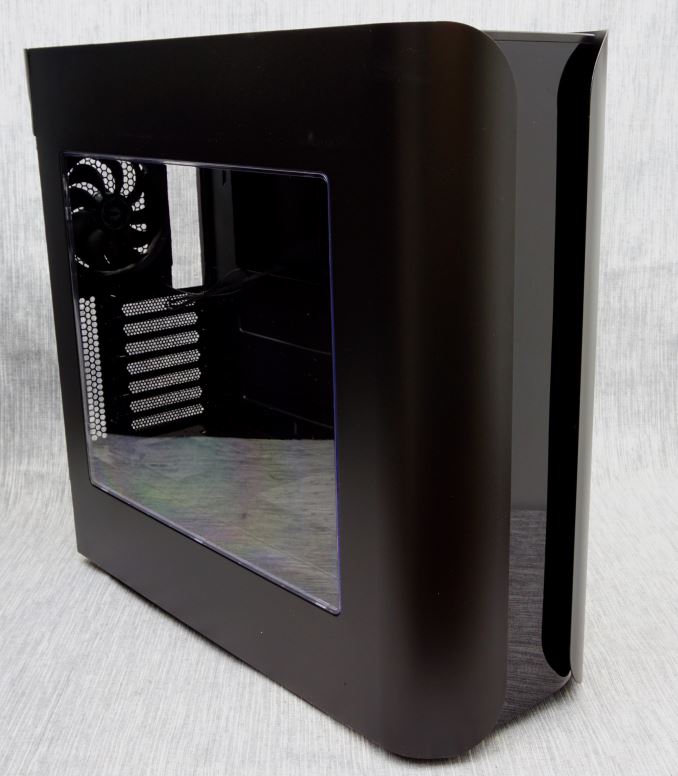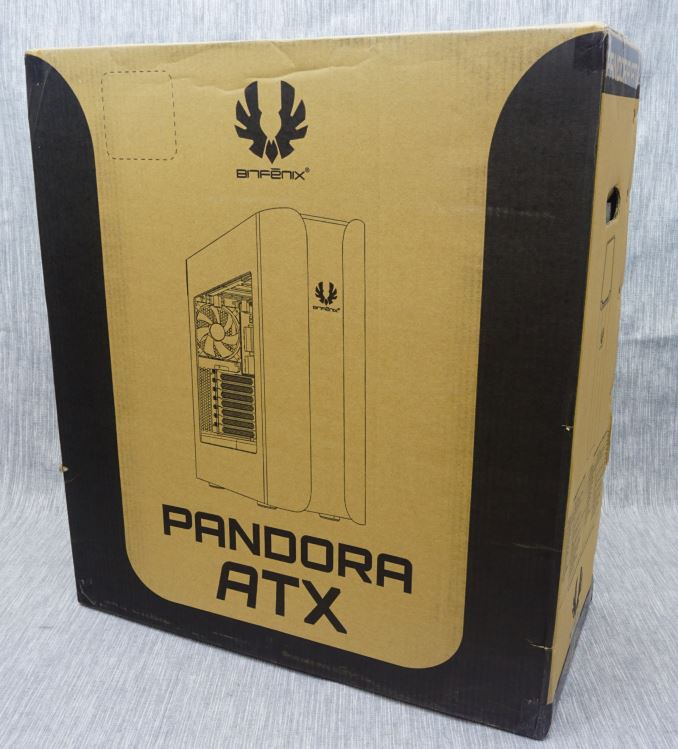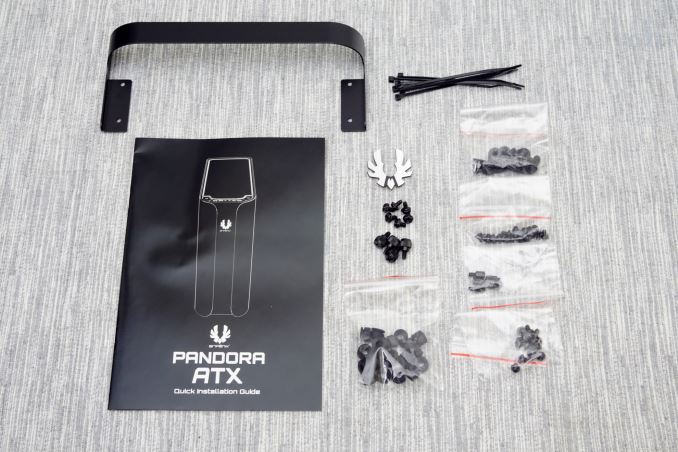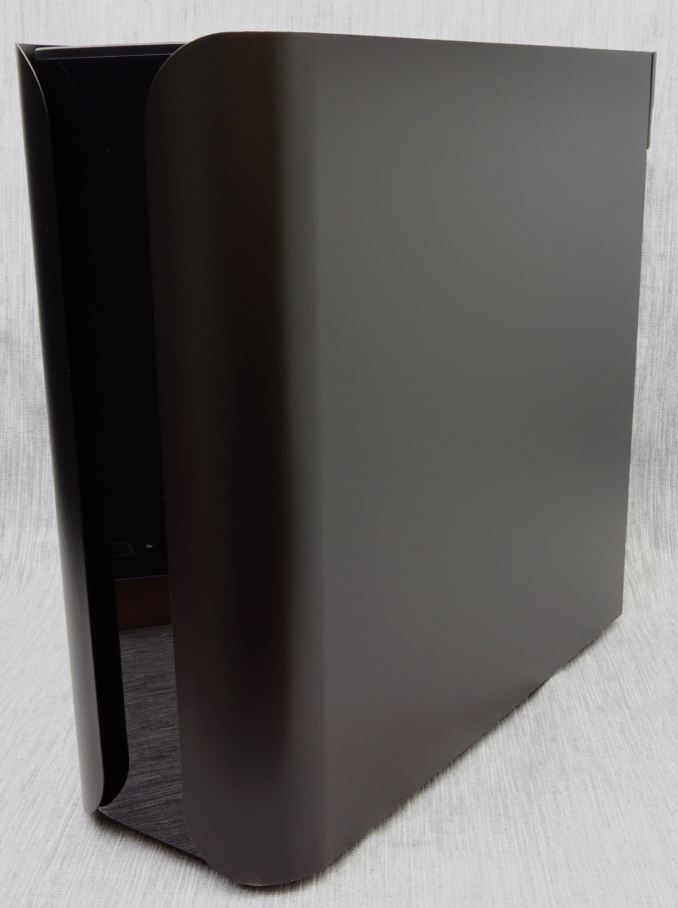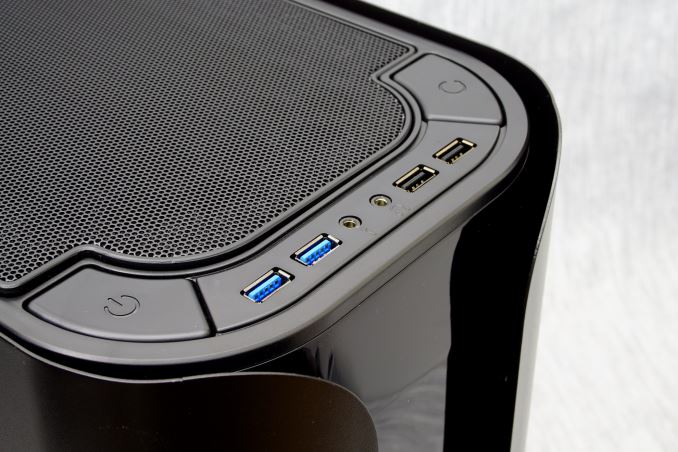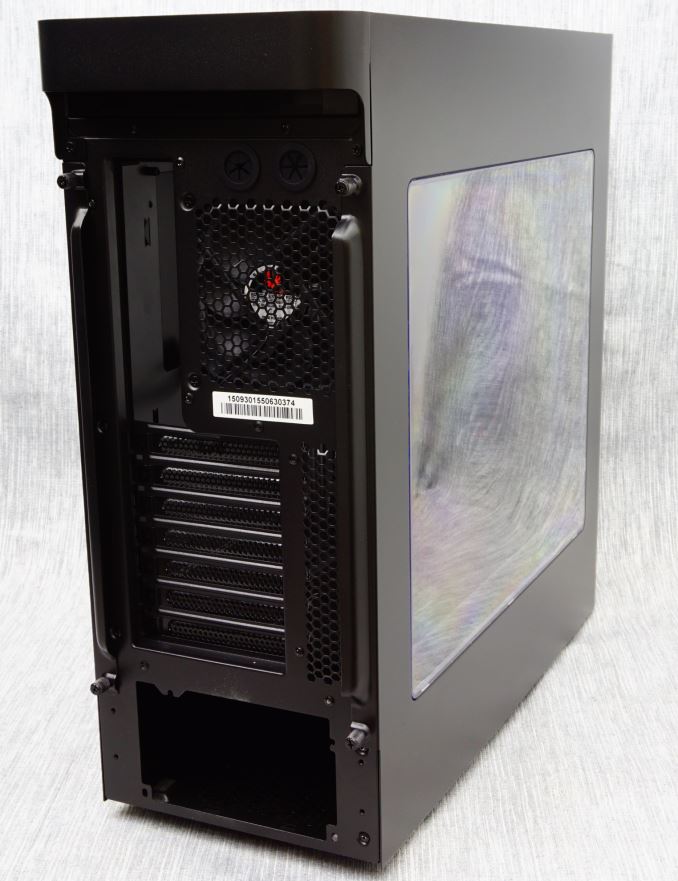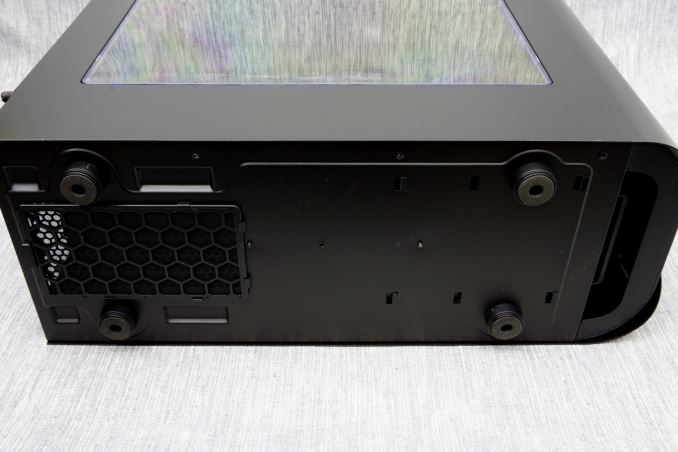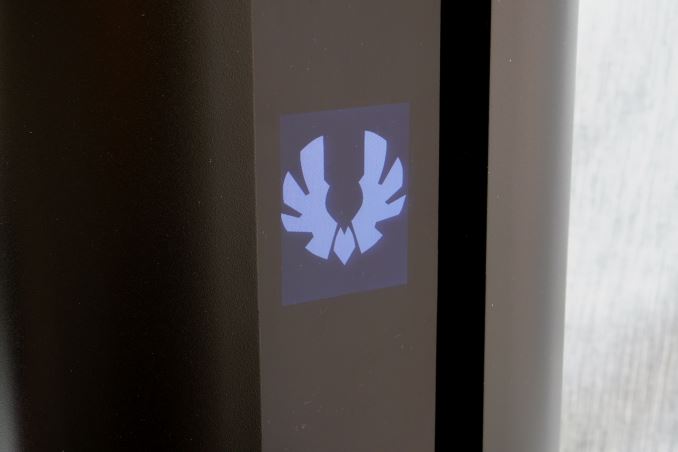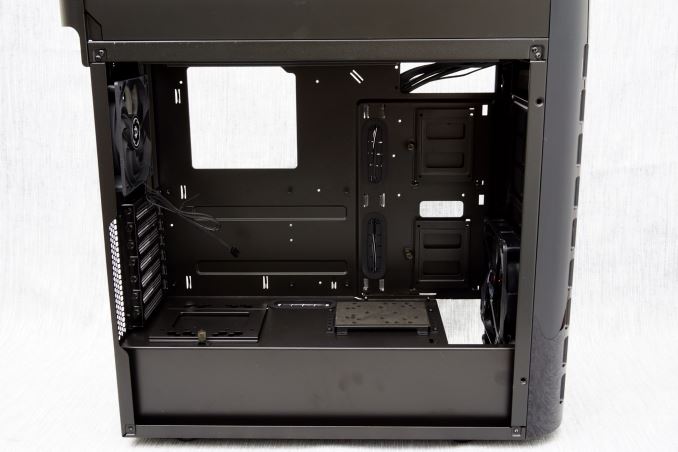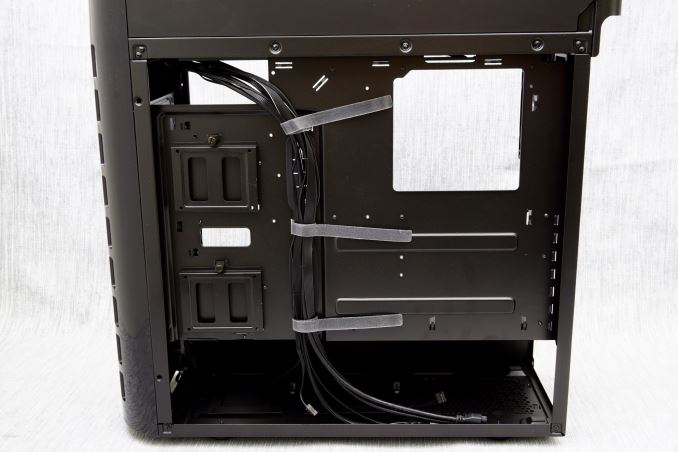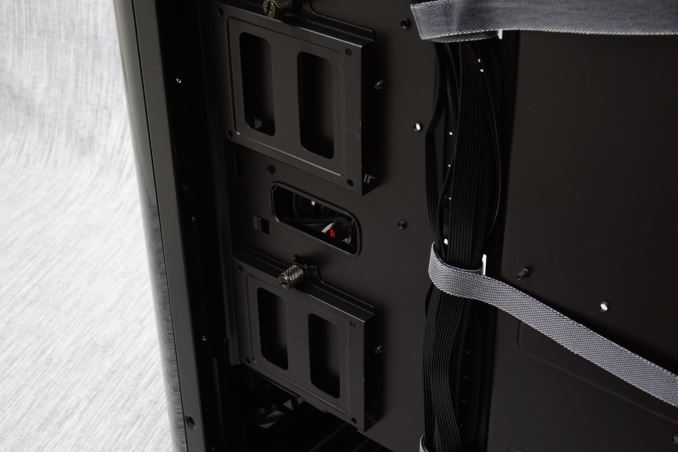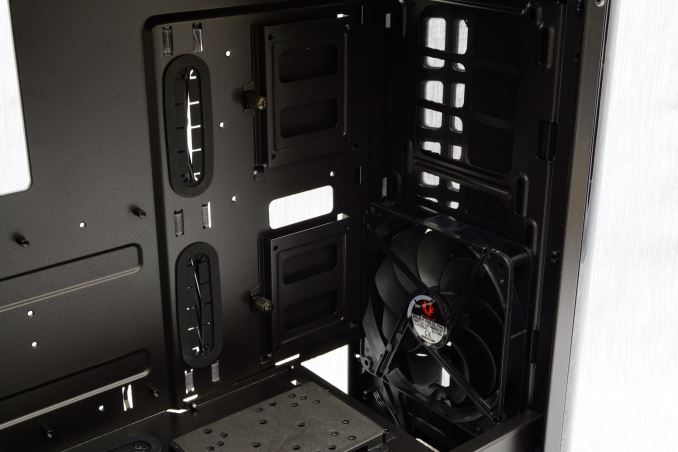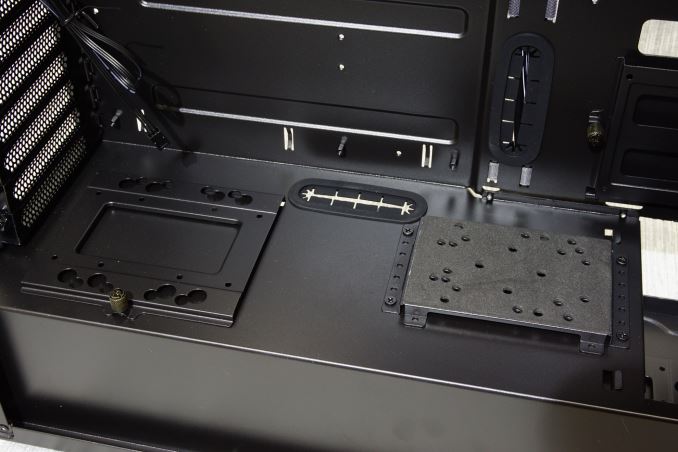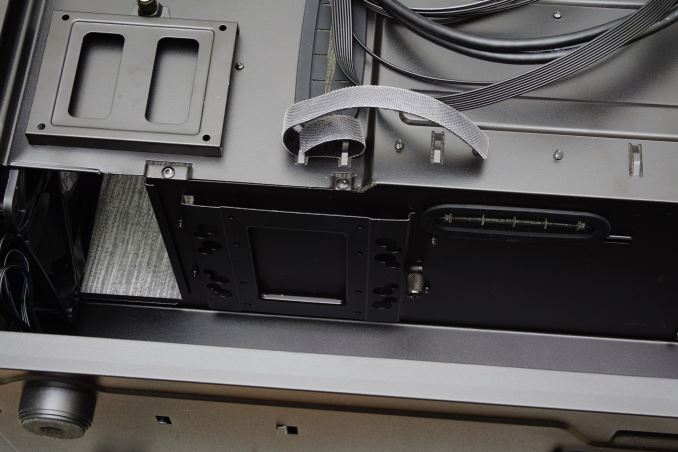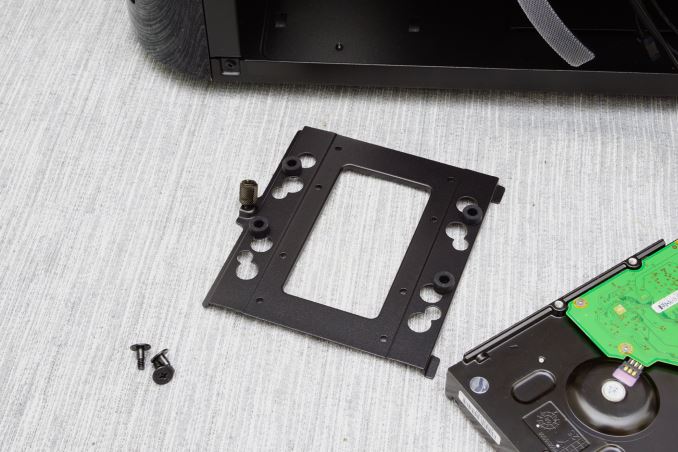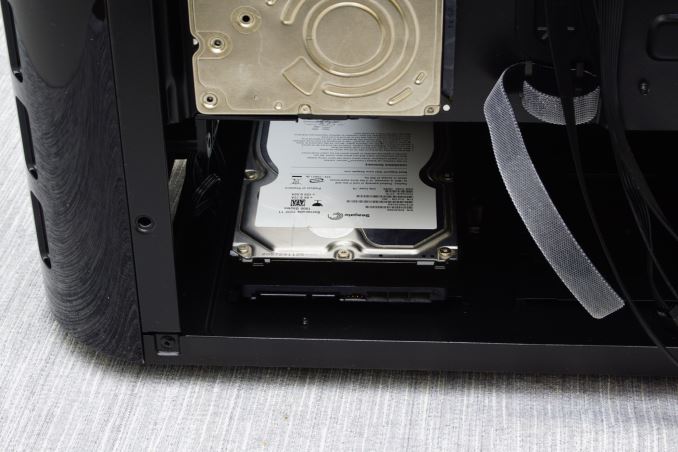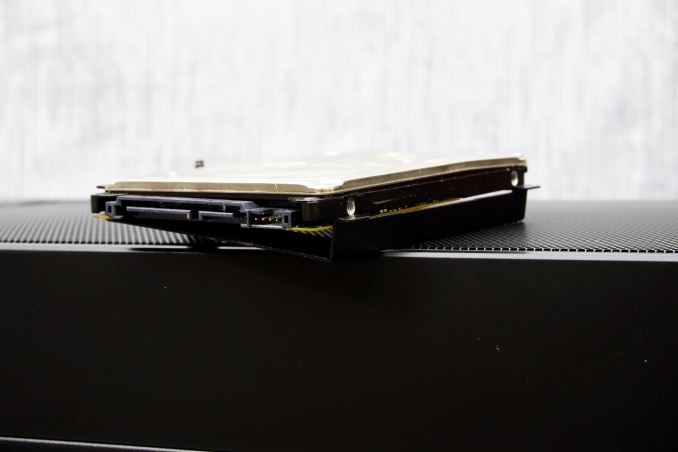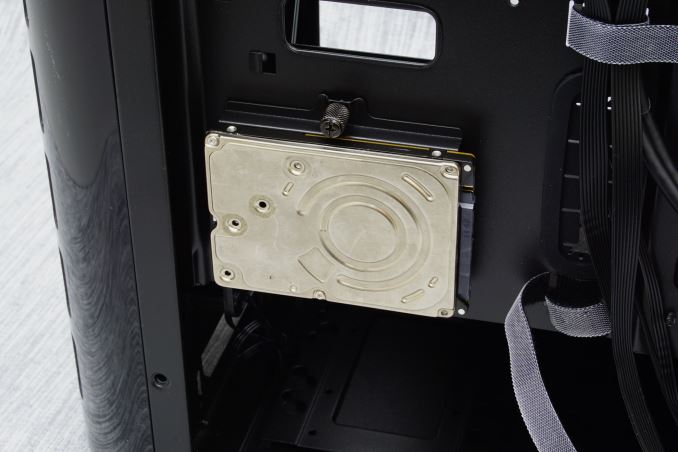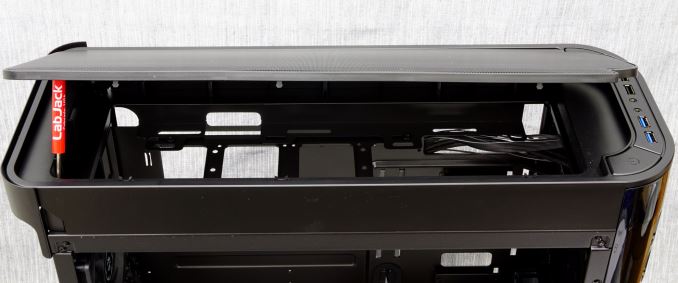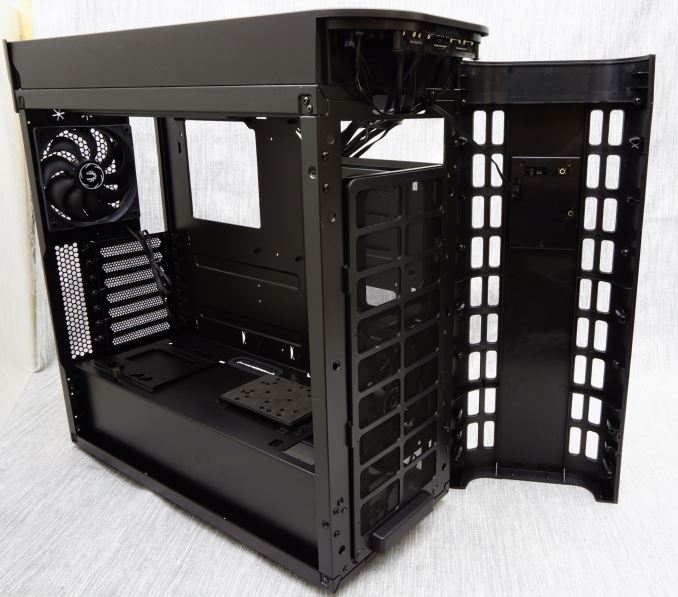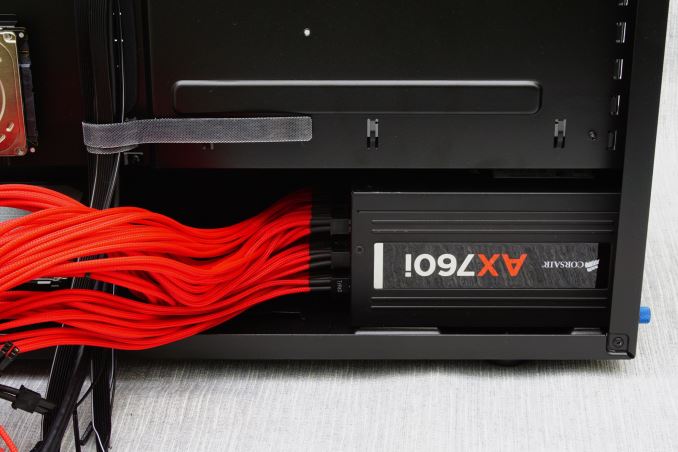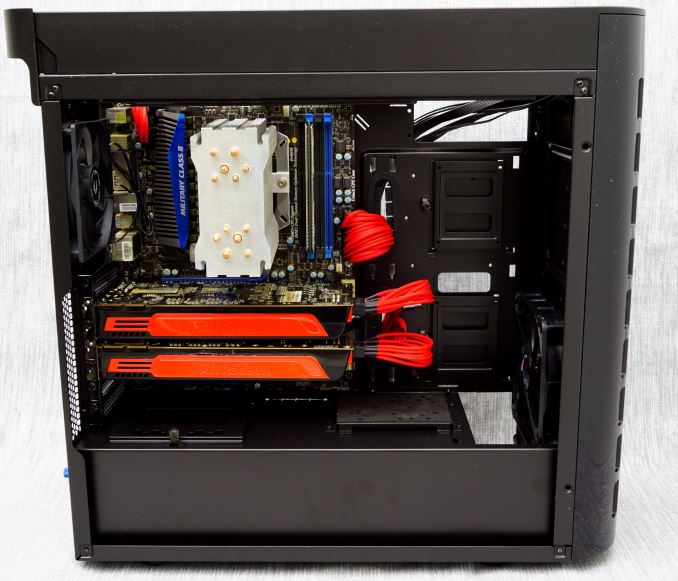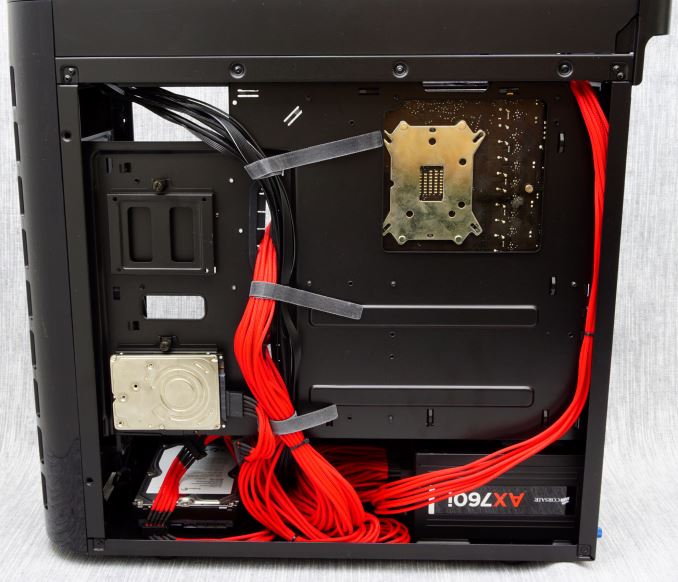
Original Link: https://www.anandtech.com/show/10551/the-bitfenix-pandora-atx-case-review
The BitFenix Pandora ATX Case Review
by E. Fylladitakis on August 11, 2016 9:00 AM EST- Posted in
- Cases/Cooling/PSUs
- bitfenix
- ATX
- Case
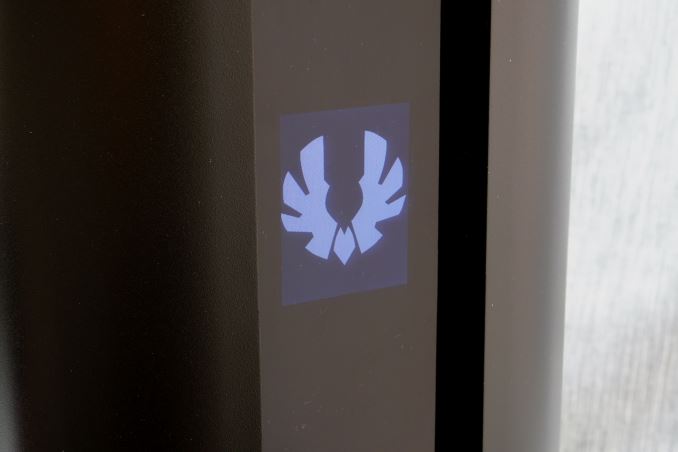
BitFenix is a company that is strongly focused on the design of PC cases and the supply of case modding parts. They currently produce over two dozen cases, covering nearly all segments of the market, with most of them being marketed as visually unique cost-effective designs. Many of their products have been through our labs, from the $39 Merc Alpha to the $159 Shinobi XL, each with its own target group, strengths, and weaknesses. Today we are looking at the latest design - a scaled up version of the Pandora.
BitFenix owes a lot of their recent success as a company to the Pandora. It is a case that was loved for its design and price to performance ratio. However, the Pandora was compact and could only take up to Micro ATX motherboards, with limited expandability and cooling options. In this review we are having a look at a newer version of the Pandora, the Pandora ATX, which shares the aesthetic design of the original Pandora but is both much larger and comes with extensive support for liquid cooling systems.
Introduction
Tthe Pandora was BitFenix’s first case with aluminum parts and designed to combine aesthetics with versatility. The original Pandora was designed for Micro-ATX and Mini-ITX motherboards only, something that was a deal breaker for many advanced users and gamers, but did not stop the case from succeeding in the market. As such, BitFenix decided to design an oversized version of the Pandora, the Pandora ATX, as a case with a similar aesthetic design but large enough to support ATX motherboards and advanced liquid cooling systems. We are having a thorough look at it in this review.
| BitFenix Pandora ATX | ||
| Motherboard Size | ATX, Micro-ATX, Mini-ITX | |
| Drive Bays | External | - |
| Internal | 4 × 3.5" 4 × 2.5" |
|
| Cooling | Front | 3 × 120 mm or 2 x 140 mm (1 × 140 mm included) |
| Rear | 1 × 120 mm (included) | |
| Top | 3 × 120 mm or 2 x 140 mm (none included) | |
| HDD | - | |
| Bottom | - | |
| Radiator Support | Front | Up to 360 mm or 280 mm |
| Rear | Up to 120 mm | |
| Top | Up to 360 mm or 280 mm | |
| Side | - | |
| Bottom | - | |
| I/O Port | 2× USB 3.0, 2× USB 2.0, 1× Headphone, 1× Mic | |
| Power Supply Size | ATX | |
| Clearances | HSF | 160 mm |
| PSU | 240 mm | |
| GPU | 440 mm | |
| Dimensions | 510 mm × 203 mm × 558 mm 20.08 in × 7.99 in × 21.97 in |
|
| Prominent Features | · 2.8" BitFenix ICON™ Display · One-piece powercover and MB tray · Top, Front and Bottom Dust Filters · 360mm Radiator Support · 20mm Cable Clearance · Graphics Card Length up to 440mm |
|
| Price | $112 | |
Packaging & Bundle
We received the Pandora ATX supplied inside a large and fairly sturdy cardboard box. The case is protected inside the box by two thick Styrofoam slabs and a nylon bag, providing adequate shipping protection. Aesthetically it may be just a brown box, but BitFenix spent some effort and resources trying to make it appealing via simple geometric artwork and a schematic of the case itself.
The items bundled alongside with the Pandora ATX are fairly standard, with the exception of a metallic brace that can be installed to give the rear of the chassis a rounded appearance. The rest of the supplied items are for the installation of devices and parts inside the case, a few cable ties, and a thick metallic company logo. As this case has an LCD installed, BitFenix thoughtfully decided to leave the installation of the case badge up to the user.
The Exterior of the BitFenix Pandora ATX
The BitFenix Pandora ATX sports the same modern design that made the original Pandora famous, with smooth surfaces and side panels that extend to the front of the case as flaps. The design concept is not new as there were a few cases similar to the Pandora in the past (e.g. ThermalTake Armor), but the Pandora was the first where the flaps were a continuous part of the side panels, combined with having no external drive bays at all. The newer version that we are reviewing today is considerably larger than the original, measuring 51 cm tall, 20.3 cm wide and 55.8 cm deep (20 × 8 × 22 in), resulting to a volume of 57.8 liters, making it 40% larger than the mATX-compliant Pandora. It is also a slightly heavy case, tipping our scales at 9.72 kg when completely empty.
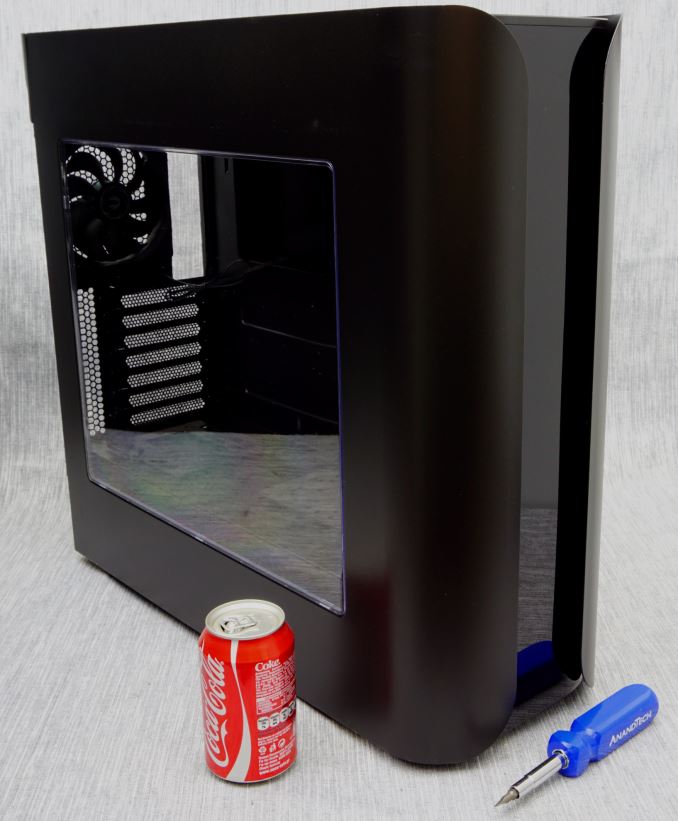 11.2 oz can inserted as a size reference
11.2 oz can inserted as a size reference
BitFenix has designed only a single black version of the Pandora ATX at this point, with a windowed side panel. A smooth, satin black paint covers the entirety of the case with the sole exception being the glossy plastic front panel. The paint is relatively resistant to fingermarks but the glossy front panel is a true fingerprint magnet and can get dirty very easily. As there is nothing the user can physically interface with on the front panel, it should not be an issue, unless if there are young children or pets roaming about the area of the PC.
The front I/O ports and buttons can be found at the top side of the front panel. A large power on button can be seen on the far left side of the symmetrical array, followed by two USB 3.0 ports, 3.5mm audio jacks at the center, two USB 2.0 ports to the right and a large reset button to the far right. There is no door or cover for the USB/audio ports.
A look at the rear of the BitFenix Pandora ATX reveals that the PSU compartment is at the bottom of the case and the presence of a stock 120 mm exhaust fan. There are also two round holes with rubber grommets for liquid cooling hoses. The metallic brace that BitFenix supplies with the bundle goes in front of the PSU, exactly as the brace that can be seen pre-installed at the top of the case’s rear side.
The BitFenix Pandora ATX sits on four simple, round plastic legs with rubber anti-slip pads installed on them. With the exception of the nylon filter covering the PSU intake, there is nothing else of interest at the bottom of the case. The front air intake filter can also be removed by pulling it downwards from the gap between the chassis and the faceplate, something easy to be done with the case on a desk or table but requires the case to be lifted up or rolled to its side if it sits on the floor.
One unique feature of the Pandora ATX is the simple LCD screen on the front panel. By default, it is showing the company logo but the users can insert any photo/logo they wish, as long as it fits certain proportions and file formats. The software used to do this is very simple, perhaps even too simple for such a product. It has no interface at all, the user is simply required to drag and drop the picture file on the program’s icon. A little more sophisticated software with a basic user interface and minor editing options would certainly be much more effective.
The Interior of the BitFenix Pandora ATX
The removal of the case’s panels reveals a relatively roomy but complex interior. BitFenix has sprayed the interior of the Pandora ATX with a matte black paint. The paint job is excellent but this particular paint is highly prone to fingermarks. Aside from the chassis and other metal parts of the case, everything inside the Pandora ATX is black, including the fans, the cables and every single screw and stand-off.
There is an opening on the motherboard tray for the installation of aftermarket CPU coolers, large enough to offer compatibility with most motherboards, yet not overly so as to expand beyond the limits of a Flex-ATX motherboard. Openings for the routing of cables can be seen to the right and below the motherboard area. Simple but effective rubber grommets cover these openings. There is another very large opening at the top right side of the system area, without a cover.
The installation of drives inside the Pandora ATX is being done on metallic trays found throughout the case. We found three 3.5” drive trays inside the bottom compartment near the front of the case, with two of them being at the bottom of the case and one at the top of the compartment. Another 3.5” drive tray is within the system area, right beneath the motherboard. The four 2.5” trays can be found to the front of the motherboard tray, two on either side of the case. It is interesting to note that the 2.5” trays inside the system area can be exchanged with 3.5” trays if the user wants to. 2.5” devices can also be installed on the 3.5” trays if needed.
The installation of the drives on the 3.5” trays is done by inserting rubber grommets on them and then securing the drive using the provided screws. As 2.5” drives do not really vibrate, BitFenix kept the 2.5” trays very simple and the drive is directly secured on the tray with typical screws.
Note that the 2.5” trays just look like they can take the device inside them - the 2.5” drive will not fit inside the tray, it is meant to be installed on it. BitFenix wants the drive to be visible when viewed from a windowed side panel.
The strange metallic mount at the bottom of the system area is a liquid cooling pump mount. BitFenix claims that it can hold every pump meant for a PC cooling setup available today. Even if a pump is not directly compatible, drilling an extra hole or two should be a cakewalk for a modder. A soft anti-vibration pad is installed on the mount to help reduce the possibility of vibration-induced noise from the pump. The concept is very interesting but the position of the mount can be problematic with a multi-GPU system, as it can block the installation of a card depending on its length and installation slot.
The top panel of the case can easily come off by simply pressing down on it. Here the user can install up to three 120 mm or two 140 mm fans and relatedly sized radiators. There is enough space between the top cover and the installation mounts for the vast majority of liquid cooling radiators available today, but we would not recommend some of the proprietary models that may be over 40 mm thick. A metallic brace can also be noticed and it is meant to serve as a mounting point for liquid cooling reservoirs, allowing the user to essentially hang them right in front of the motherboard.
Up to three 120 mm or two 140 mm fans and relatedly sized radiators can also fit at the front of the BitFenix Pandora ATX. Access is gained by carefully pulling the faceplate off, as the cable attached to the front LCD can be easily damaged. One 140 mm fan with a fluid dynamic bearing engine has been installed at front of the case from the factory.
The PSU compartment is roomy, allowing PSUs up to 240 mm in length to be installed. There is a hole right above the PSU leading directly to the system area, but the intended path for the cables is alongside the edge of the motherboard, where BitFenix installed three long cable straps. Cable tie mounting points can be seen all across the rear of the motherboard tray.
For the means of this review, we installed a Corsair AX760i with the red cable set, for strong visual contrast. The AX760i easily fits inside the BitFenix Pandora ATX, with more than enough room for managing the cables. Most of the cables will probably be amassed across the side of the motherboard’s tray, secured by the straps. They may create a rather thick bundle but the Pandora ATX has a clearance of 23.5 mm between the chassis and the side panel, which should prove to be more than enough. We do feel that the cable management straps should be a little to the side as they force the cables to go over the openings and they are amassed too close to the 2.5” drive trays, but this is not a major issue, only a practical nuisance.
The ATX system fits inside the system area of the Pandora ATX like a glove, allowing the installation of large air coolers, liquid coolers and long/wide graphics cards. The space in front of the motherboard, allowing cards up to 440 mm long to the installed, but it can be seen that the presence of a pump on the intended mount would most likely block the installation of our second card. The CPU cooler’s maximum height is 160 mm and will create compatibility problems with many top-tier air coolers, hinting that this case has been primarily designed with liquid cooling in mind.
Test Setup
Professional testing requires the emulation of real-world situations but with repeatable results; thus, a perfectly controllable test setup and environment are required, especially for comparable results. Testing the thermal performance of any case with a typical real-world setup technically limits the comparability of the results to this setup alone, as an active system interacts with its environment and the change of a single component would alter myriads of variables. As such, we developed synthetic loads that emulate the thermal output of real systems, which however are passive, steady and quantifiable. As such, the thermal testing now displays the thermal capabilities of the case alone, as if it would have to deal with the entire thermal load by itself, regardless of the system that would be installed inside it. Laboratory data loggers are being used to monitor the PT100 sensors and control the safety relays, which are fully accessible via our custom software. Three such loads have been developed; the ATX version simulates a 200W CPU, 50W VRM, 30W RAM and 4 × 120W GPU card thermal load. Finally, three 3.5" HDD dummy loads have also been created, with each of them converting 30 W of electrical power to thermal, bringing the total thermal load of the ATX test setup up to 850 Watts. As such, the thermal load is immense and only the best of cases will be able to handle it for more than a few minutes, we are also performing a test with a thermal load of 400W, with all of the aforementioned components except the HDD drives at about 42% power, which is more suitable for the majority of cases.
Noise testing has been performed with a background noise level of 30.4dB(A). Advanced noise testing is also being performed, in order to assess the ability of the case to dampen the noise of the components installed inside it. This includes the installation of two noise-generating sources (strong fans) inside the case, one positioned approximately over the first expansion slot and one over the CPU area, which generate ≈ 44.2 dB(A) when unobstructed. During the advanced noise test, all stock cooling options of the case are entirely disabled.
Results & Discussion
The thermal performance of the BitFenix Pandora ATX is good considering the stock cooling options and size of the case. It handles a very large thermal load very well, yet there are no notable performance differences between it and competitive products. Our measurements showed that the Pandora ATX is slightly better than the Cooler Master MasterCase 5 and falls a little behind the Riotoro Prism CR1280 and the Corsair 760T. The readings coming from our dummy HDD loads installed inside the PSU compartment however were relatively high, especially considering that the front intake fan is positioned so as to enhance the cooling of that area.
The stock cooling fans of the Pandora ATX provide sufficient airflow to insure the good thermal performance of the case at very reasonable noise levels. With the fans running at their maximum speed, our instrumentation recorded 36.2 dB(A) from one meter away in an environment with a background noise level of 30.4 dB(A). This corresponds to an audible but subtle humming noise coming mostly from the air moving through the openings and filters. At lower speeds, the stock cooling fans are virtually inaudible.
BitFenix did not specifically design the Pandora ATX to be a very quiet case and the design does not use active noise reduction measures, such as the installation of sound dampening material on the panels of the case. Nevertheless, the design of the Pandora ATX lacks any direct openings to the front of the case and that does dampen the noise of the installed equipment by a small, yet clearly noticeable level. Our instrumentation measured a drop of 3.5 dB(A) during our advanced testing, a perceptible difference by an average person.
Conclusion
Even though the Pandora ATX is aesthetically based on the original Micro-ATX version of the Pandora, any similarities between the two cases are limited to just their aesthetic design. Where the original version was meant for users who would like a beautiful case for a relatively strong but mainstream PC, the Pandora ATX is directed towards a completely different target group. The size, design, versatility and emphasis on liquid cooling support of the Pandora ATX dictate that it has been designed for users that will be installing very powerful and quite possibly overclocked hardware. The target group that the Pandora ATX is aimed to is very demanding and difficult to please. Even the smallest detail can affect the buyer’s decision and the Pandora ATX is definitely not without flaws.
The primary selling point of the Pandora ATX undoubtedly is, aesthetically speaking, its design. Aesthetics are a subjective matter but it is no secret that the original Pandora was a case loved by modders and users that would place their systems in areas that would make them visible by their friends or guests (e.g. living rooms). It is obvious that BitFenix is trying to replicate this success with the Pandora ATX for users that did not like the limitations of a Micro-ATX build. However, the size of the Pandora ATX is restrictive, as a case this size would look out of place in a simple, modern living room. On the other hand, the roomy case can house powerful hardware and advanced liquid cooling systems, making it ideal for advanced modders and liquid cooling aficionados that want to showcase their work or for large VR systems.
BitFenix tried their best to make the Pandora ATX a versatile case, easing up the work of modders and especially those that plan to install advanced liquid cooling parts. The capability to interchange the front 2.5” and 3.5” trays is interesting, as is the presence of liquid cooling tank and pump supports. The vast majority of commercial liquid cooling parts should be compatible with the Pandora ATX, from large 360 mm radiators to high pressure 12V pumps. The position of the pump mount however creates compatibility issues, as it would most likely block the installation of even a second advanced GPU. It is very strange why the designer did not place this mount down inside the PSU compartment area, where the 3.5” drive trays have been placed. This would limit the number of 3.5” drives, reducing them by at least two, but the pump would stay out of the way of the GPU cards. Those that will be installing more than one GPU will most likely be modifying the case so as to move the pump inside the bottom compartment. Finally, tanks that have been designed for installation in 5.25” device slots obviously are incompatible, as the Pandora ATX does not support 5.25” devices.
The build quality of the Pandora ATX has left us with mixed feelings. It is not uncommon to see cases with mediocre panels on a good chassis or with simple, low quality stock cooling fans installed when designers are trying to cut down the manufacturing costs. In this instance however, it seems as if the designer of the Pandora ATX worked the other way around. The front panel and plastics of the case are of excellent quality and very high quality FDB bearing cooling fans have been installed, whereas the chassis and side panels are relatively thin and weak for a case of this size. It is likely that BitFenix is using the same materials and thickness as with the original Pandora, which was significantly smaller and lighter. The result is a rather malleable chassis that could face permanent damage if mishandled with heavy hardware installed into it and side panels that are susceptible to dents, especially on the flaps extending in front of the case.
In our opinion, the greatest advantage of the Pandora ATX against the competition is its retail price. The case can be found for $112 including shipping at the time of this review, a very fair price for its size, versatility and features. There are few cases of this size at this price point where the designer emphasises on aesthetics and, at the same time, provides exceptional support for advanced liquid cooling setups. We feel that the Pandora ATX will become a favourite among enthusiasts that are building powerful, liquid cooled gaming systems and want to create an aesthetically pleasing result with relatively low effort and custom modifications.

